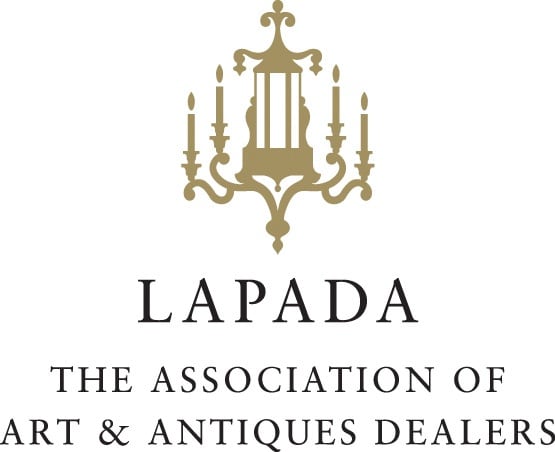Louis le Brocquy 1916-2012
Tinkers Enter the City , 1946
Pen and ink and watercolour
Unframed: 23 x 33.5 cm.; 9 x 13 in.
Framed: 46.5 x 53 cm.; 18¼ x 20¾ in.
Framed: 46.5 x 53 cm.; 18¼ x 20¾ in.
Signed and dated lower right 'LE BROCQUY 46'
WB3133
Copyright The Artist
The present work is a rare and highly accomplished watercolour that belongs to le Brocquy's Tinker Series which, in 1946 at twenty-nine years old, announced le Brocquy's arrival on the...
The present work is a rare and highly accomplished watercolour that belongs to le Brocquy's Tinker Series which, in 1946 at twenty-nine years old, announced le Brocquy's arrival on the contemporary art scene, receiving critical acclaim. Le Brocquy first encountered the Tinkers in 1945 whilst working near Tullamore, County Offaly. This travelling community peculiar to Ireland, trading traditionally as tinsmiths, claim descent from those displaced by the persecution and famine in Ireland’s history. Living outside of accepted society with their own language and rituals, their intractability and independence resonated with le Brocquy: 'Most of all I was impressed by their insistence on freedom - freedom from every external regulation - observing only their own tribal rules, their tradition. Not, perhaps, altogether unlike the independence of the artist within society’ (Louis le Brocquy, The Inner Human Reality, film documentary, RTE 1, 21 February 2006). This interest with 'outsiders' and displaced people formed part of a wider European concern that found expression through artists wrestling with the direction of humanity in the wake of World War II.
Le Brocquy was the leading avant-garde painter of his generation in Ireland, challenging the status quo and consciously adopting a modern visual language. In 1946 he moved to London and formed friendships with many of the city's leading painters, including Keith Vaughan, John Minton, William Scott, McBride and Colquhoun, Francis Bacon and the Polish painter Jankel Adler who, as a friend of Picasso and the European avant-garde, represented a direct link to European artistic developments. Just the year before, le Brocquy had seen Picasso's work at the Victoria & Albert Museum, and his knowledge of Cubism is evident in the fractured, multi-dimensional composition of the present watercolour. The triangular faces also connect with artists looking to 'primitive' cultures, perhaps most famously in the work of Picasso, challenging the West's presumptions of society. Their shape also takes inspiration from the archaic forms in the figures on the Celtic high cross at Moone in Co. Kildare that le Brocquy encountered, and references to which connect the Travelling community with their ancient origins.
As the Tinkers enter the city, they form a lively procession - observers and observed; shop-keepers, vendors and a bicycle hint at the urban environment.
Le Brocquy developed these watercolours into a major series of celebrated oil paintings which he completed after his move to London (and his own entry to the city); it includes works such as Tinkers Resting, which was bought by the Tate, via the Leicester Galleries, in 1956, and Travelling Woman with Newspaper (sold Sotheby's, London, 18 May 2000, lot 158).
Le Brocquy was the leading avant-garde painter of his generation in Ireland, challenging the status quo and consciously adopting a modern visual language. In 1946 he moved to London and formed friendships with many of the city's leading painters, including Keith Vaughan, John Minton, William Scott, McBride and Colquhoun, Francis Bacon and the Polish painter Jankel Adler who, as a friend of Picasso and the European avant-garde, represented a direct link to European artistic developments. Just the year before, le Brocquy had seen Picasso's work at the Victoria & Albert Museum, and his knowledge of Cubism is evident in the fractured, multi-dimensional composition of the present watercolour. The triangular faces also connect with artists looking to 'primitive' cultures, perhaps most famously in the work of Picasso, challenging the West's presumptions of society. Their shape also takes inspiration from the archaic forms in the figures on the Celtic high cross at Moone in Co. Kildare that le Brocquy encountered, and references to which connect the Travelling community with their ancient origins.
As the Tinkers enter the city, they form a lively procession - observers and observed; shop-keepers, vendors and a bicycle hint at the urban environment.
Le Brocquy developed these watercolours into a major series of celebrated oil paintings which he completed after his move to London (and his own entry to the city); it includes works such as Tinkers Resting, which was bought by the Tate, via the Leicester Galleries, in 1956, and Travelling Woman with Newspaper (sold Sotheby's, London, 18 May 2000, lot 158).
Provenance
Gimpel Fils, LondonHoward Bliss Esq
Redfern Gallery, London
Heffel Fine Art Auction House, Toronto, 27 November 2003, lot 3
Sotheby's, London, 11 May 2006, lot 108
Dolans, Galway, 20 November 2006, lot 85
Sotheby's, London, 16 November 2011, lot 163
Private collection (purchased from the above)
Exhibitions
London, Gimpel Fils, Le Brocquy Watercolours, May - June 1947, no.33;New York, Brooklyn Museum, British Council, 17th Biennial, International Watercolour Exhibition, 1953, no.18;
London, Gimpel Fils, Works on Paper, February - March 1976, no.32;
London, Gimpel Fils, Louis le Brocquy, April - May 1991, no.2
Join our mailing list
Be the first to hear about our upcoming exhibitions, events and news
* denotes required fields
We will process the personal data you have supplied to communicate with you in accordance with our Privacy Policy. You can unsubscribe or change your preferences at any time by clicking the link in our emails.

